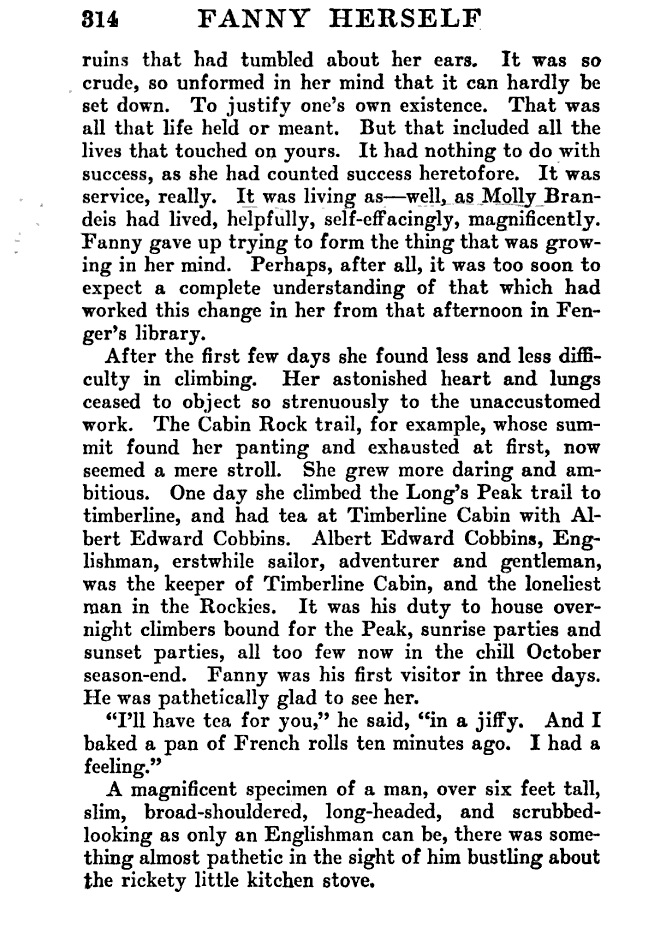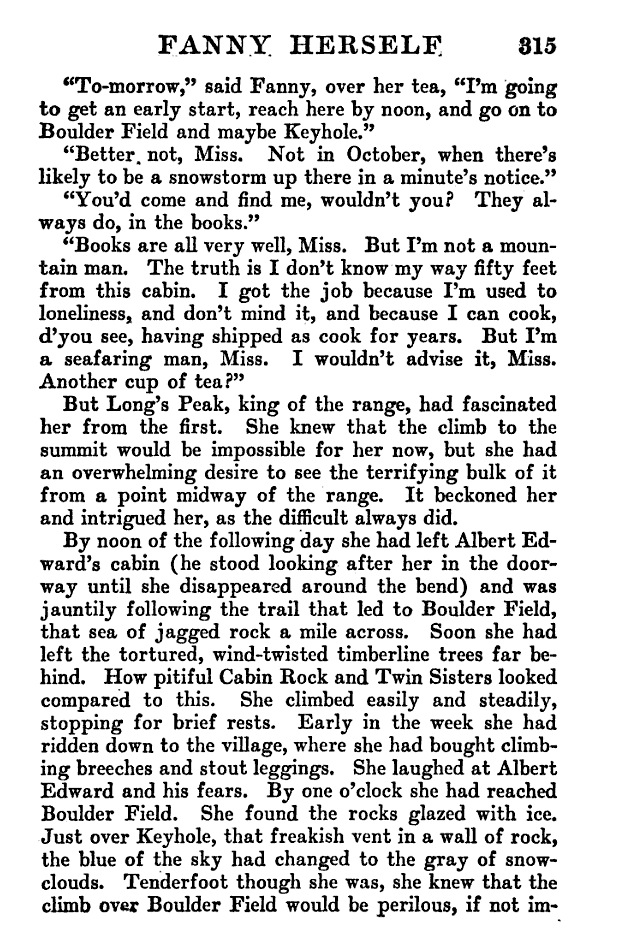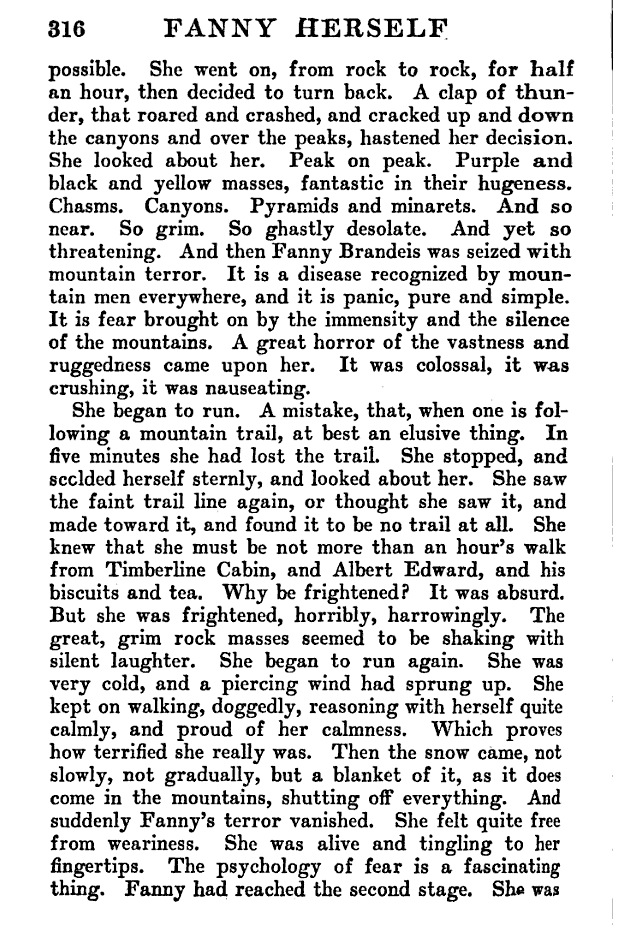From "A Peculiar Treasure", Edna Ferber, 1939, page 243:
In my visits to Estes I had been fascinated by the Peak, had been really hypnotized by it, as is almost very visitor to that region. There it towers, taunting you as you gaze up at its jagged cliffs. Scaling it made a tough climb of perhaps twelve hours, there and back. The last tree or four hours of the climb meant crawling, sliding, slipping; hand over hand; sometimes a sheer drop of two thousand feet below you, and you on a shelflike ledge. I hated the thought of it. That kind of adventure repels me. But climb it I had to, once and for all. Get it over with. It wasn't until 1921 that I made it with the aid of Shep Husted. Shep, mountain guide and perfect gentle knight, may be sixty now, maybe seventy; he's changeless and seemingly indestructible as Longs Peak itself. Shep is made of iron and gold and granite in pleasing proportions, like the Rockies. He is tireless, dependable, cautious and wise in the ways of mountains. His feet, in their find riding boots, are slim, neat, high-arched as a girl's . His voice is gentle, slightly drawling. He ought to be in a book but he's too fanciful for fiction. I tried to sneak him into Fanny Herself but he wouldn't fit. Too perfect. He left the imagination nothing to work on.
From "Estes Park Trail", Section Two, Jan. 1, 1988
EP's 'Shepherd' true Christmas spirit.
Edna Ferber, the novelist, came to Estes Park in the early 1900s for the first time. She was fascinated with the area, and returend on a almost annual basis for many years thereafter.
By 1921 she was so tired of being asked by her New York friends if she climbed Longs Peak while in Colorado for the summer that she engaged Shep Husted to guide her to the top.
According to some accounts, Miss Ferber was a "poor climber" but she did conquer the peak.
Later, in her book "Peculiar Treasure", she wrote, "It wasn't until 1921 that I made it with the aid of Shep Husted. Shep, mountain guide and perfect gentle knight, may be sixty now, maybe seventy; he's changeless and seemingly indestructible as Longs Peak itself. Shep is made of iron and gold and granite in pleasing proportions, like the Rockies. He is tireless, dependable, cautious and wise in the ways of mountains".
All of those attributes served Shep well over the many years he lived and served in the Estes Park area.
In the summer of 1914 Shep Husted outfitted and guided a two-week pack trip with three Arapaho Indians through the Estes Park-Grand Lake region.
He was chosen because of his reputation as a guide, and his familiarity with the local place names.
The trip was arranged in order to learn the Arapaho names for the area from some indians who had lived here in their youth, before white settlement.
A 1939 Estes Park Trail states "Shep Husted, veteran guide in the Estes-Rocky Mountain National Park,has climbed Longs Peak 938 times in the 52 years that he has spent in the region. He made his last trip up the peak in 1936, but he said that during the summer seasons in years past he has made as many as 26 trips (in a single month) up the 14,255 foot mountain".
Shep was married to Clara Gertrude Crawford on June 29, 1892, in Denver and they homesteaded early in 1893 on Devil's Gulch Road.
Shep had learned the carpenter trade from his uncle John Cleave (his mother's younger sister, Margaret, was Mrs. Cleave), so they soon had a cabin built for themselves, cottages to rent for summer tourists, and plans began for building the Rustic Hotel.
The Rustic opened in 1901, was later sold to Charles Lester who renamed it the Lester Hotel, and after his health failed it was bought by the Livingston family, and is now the H-Bar-G Ranch.
On Oct 8, 1941, Shep resigned from his duties as general foreman with the Civilian Conservation Corps in Rocky Mountain National Park for health reasons, and the Husteds moved to St. Louis, Mo.
They would have celebrated their 50th wedding anniversary in 1942, but Shep died on Feb. 14 of that year at the home of his son, Kenneth, in St. Louis.
Many pages could be written about Shep Husted; his friendships, his experiences, his accomplishments.
We can't do that now, but we can tell you what these few things written today have to do with this week in history.
If you don't know, did you ever wonder how he got the name "Shep"?.
What better name could have been chosen for someone destined to lead thousands in a "tireless, dependable, cautious and wise" manner than Shephard.
Especially if that someone was born Christmas Day, 1879.
Following is a portion of the story "Fanny Herself" by Edna Ferber (1917), in which Estes Park and a climb on Longs Peak are described. See here for the entire story.



From Estes Park Trail
3 August 1923 – Headline: Popular Author Visiting Estes Park. Edna Ferber, so well known to the magazine readers of the country, is spending three weeks in Estes Park, a guest at Longs Peak Inn. Miss Ferber will be remembered for some of her productions, such as “Gigolo”, “The Girls”, “Fanny, Herself” [which includes an Estes Park setting],“Roast Beef Medium”, etc. She will also be remembered as the author of “Our Mrs. McChesseney”, a play presented for two years to the American public by Ethel Barrymore. “1200 a Year” is another of her plays that has been popular. Just before coming to Estes Park, Miss Ferber completed a new novel that will be published first in serial form by the Woman’s Home Companion, probably beginning with the New Year’s number. We are not permitted to announce in advance of the publisher’s announcement the title of this new story. It will appear in the spring in book form from the press of Doubleday-Page and Company. On 18 August 1923, Miss Ferber will leave Estes Park for Chicago, Illinois, for a brief stay, and then go to New York City. She is at the present time under contract for eight short stories for The Cosmopolitan and one play to be completed within the next twelve months. This will keep her very busy. The story just completed required eight months time for completion. Miss Ferber has been coming to Estes Park for eight or nine years, missing only the season of 1922, when she made a trip to Europe. [See also the 8 May 1925 Estes Park Trail article announcing her winning of the Pulitzer Prize for the novel “So Big”. That article indicates she wrote this novel in Estes Park in the summer of 1923.]